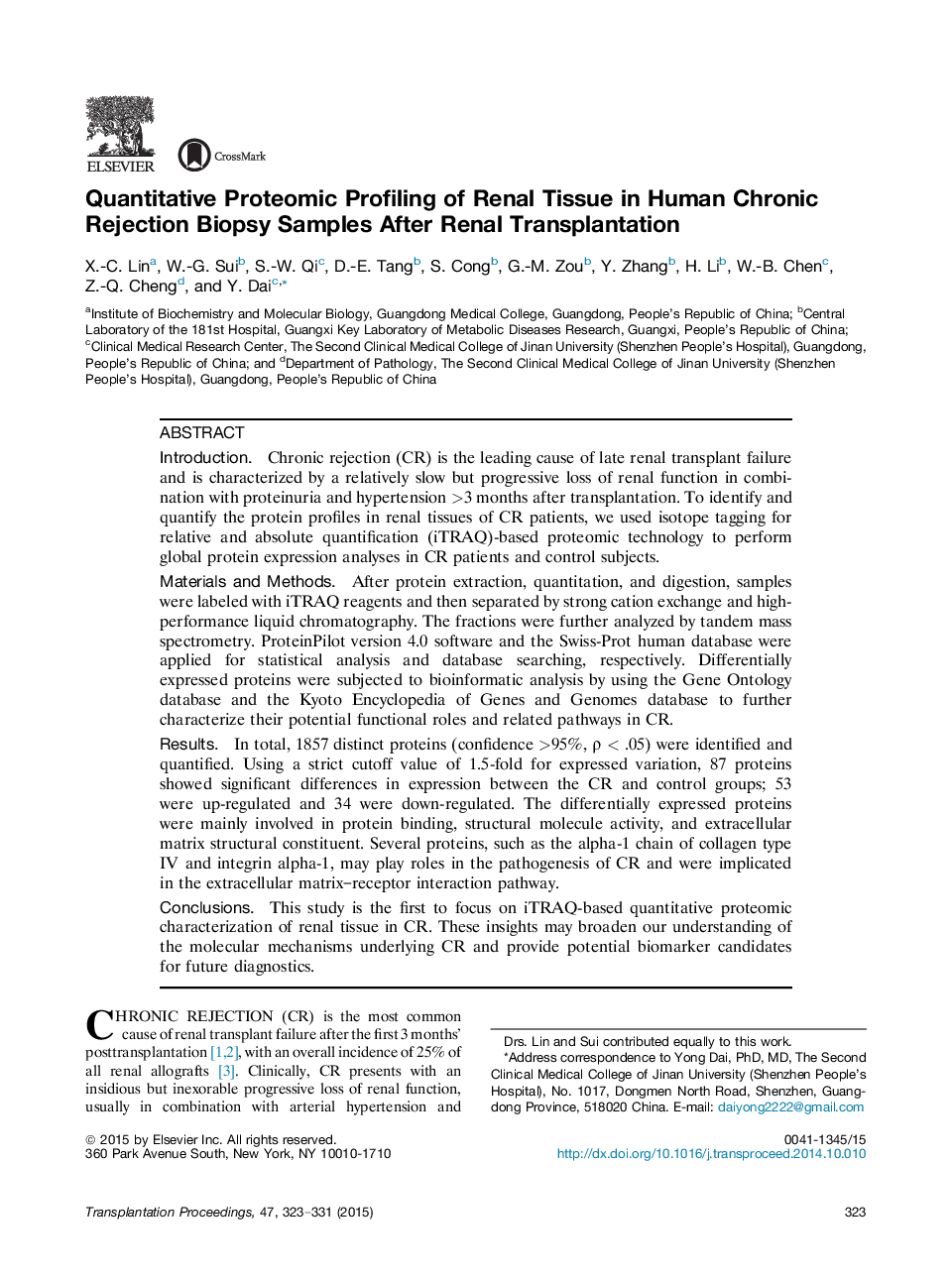| کد مقاله | کد نشریه | سال انتشار | مقاله انگلیسی | نسخه تمام متن |
|---|---|---|---|---|
| 4257603 | 1284547 | 2015 | 9 صفحه PDF | دانلود رایگان |

• Chronic rejection (CR) is the most common cause of renal transplant failure after the first 3 months' posttransplantation, with an overall incidence of 25% of all renal allografts. Owing to the lack of reliable biomarkers and molecular targets, therapy and precise diagnosis of CR are difficult.
• In the postgenomics era, mass spectrometry (MS)-based quantitative proteomics have become powerful methods for the simultaneous, integrated investigation of a large number of proteins, and thus in the search for disease-related biomarkers and drug targets; they have facilitated earlier and more exact diagnoses and improved understanding of the complex molecular basis of pathologic processes. Several techniques have been developed for MS-based proteomics, including 2-dimensional fluorescence difference gel electrophoresis, isotope-coded affinity tags, stable isotope labeling with amino acids, and isotope tagging for relative and absolute quantification (iTRAQ). Among these technologies, the advantage of iTRAQ over other relative quantitation methods is that identical peptides originating from various specimens and labeled with different iTRAQ reagents are indistinguishable in MS scans, leading to higher MS/MS intensity and more confident peptide identifications. However, relative quantitation is achieved by measuring the differences in abundance between the reporter ion fragments without affecting the product ion response used for peptide sequencing, thus improving peptide ionization. In addition, unlike stable isotope labeling with amino acids, iTRAQ-labeling reaction is not performed using live cells and is compatible with all types of protein samples.
• In recent years, iTRAQ technology has been successfully applied in the discovery of disease-related biomarkers from various clinical specimens, such as plasma, urine, cerebrospinal fluid, and tissue samples. However, to the best of our knowledge, iTRAQ technology has not been used to investigate renal tissue samples in CR.
• In our present study, 1857 distinct proteins were identified and quantified by using iTRAQ technology. Using a strict cutoff value of 1.5-fold for expressed variation, 87 proteins exhibited significant differences in expression between the CR and control groups. The differentially expressed proteins may be involved in the humoral immune response, transplant glomerulopathy, extracellular matrix–receptor interactions, which play important roles in the pathogenesis of CR. These constitute baseline data on preliminary biomarker candidates that may be useful to discover novel biomarkers for CR. To the best of our knowledge, this is the first study to use iTRAQ-based quantitative proteomic analysis of renal tissue in CR, which may broaden our understanding of the molecular mechanisms of CR. Our investigations also provide a platform for preliminary exploration of potential protein biomarkers in CR.
IntroductionChronic rejection (CR) is the leading cause of late renal transplant failure and is characterized by a relatively slow but progressive loss of renal function in combination with proteinuria and hypertension >3 months after transplantation. To identify and quantify the protein profiles in renal tissues of CR patients, we used isotope tagging for relative and absolute quantification (iTRAQ)-based proteomic technology to perform global protein expression analyses in CR patients and control subjects.Materials and MethodsAfter protein extraction, quantitation, and digestion, samples were labeled with iTRAQ reagents and then separated by strong cation exchange and high-performance liquid chromatography. The fractions were further analyzed by tandem mass spectrometry. ProteinPilot version 4.0 software and the Swiss-Prot human database were applied for statistical analysis and database searching, respectively. Differentially expressed proteins were subjected to bioinformatic analysis by using the Gene Ontology database and the Kyoto Encyclopedia of Genes and Genomes database to further characterize their potential functional roles and related pathways in CR.ResultsIn total, 1857 distinct proteins (confidence >95%, ρ < .05) were identified and quantified. Using a strict cutoff value of 1.5-fold for expressed variation, 87 proteins showed significant differences in expression between the CR and control groups; 53 were up-regulated and 34 were down-regulated. The differentially expressed proteins were mainly involved in protein binding, structural molecule activity, and extracellular matrix structural constituent. Several proteins, such as the alpha-1 chain of collagen type IV and integrin alpha-1, may play roles in the pathogenesis of CR and were implicated in the extracellular matrix–receptor interaction pathway.ConclusionsThis study is the first to focus on iTRAQ-based quantitative proteomic characterization of renal tissue in CR. These insights may broaden our understanding of the molecular mechanisms underlying CR and provide potential biomarker candidates for future diagnostics.
Journal: Transplantation Proceedings - Volume 47, Issue 2, March 2015, Pages 323–331